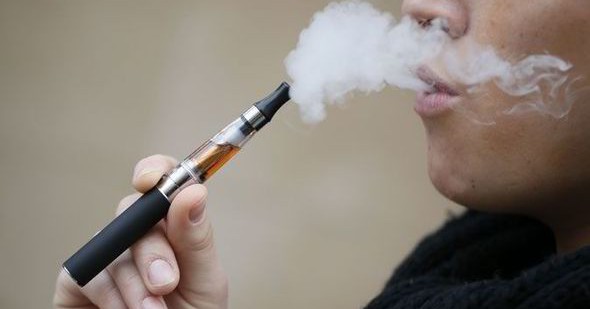
While electronic cigarettes — or ‘e-cigarettes’ — are often marketed as a safer alternative to traditional cigarettes and even as smoking cessation aids, new research suggests that the devices might actually be a toxic replacement for tobacco products.
Scientists from the University of Rochester found that emissions from e-cigarette aerosols and flavorings damage lung cells by creating harmful free radicals and inflammation in lung tissue. The findings, which are published in the journal PLOS ONE, add to a growing body of scientific data that points to dangers of e-cigarettes and vaping.
Led by Dr. Irfan Rahman, Ph.D., a professor of Environmental Medicine at the UR School of Medicine and Dentistry, the study suggests the harm begins when the e-cigarette’s heating element is activated. The heating element is designed to turn a liquid solution (known as an e-liquid or “juice”) into an aerosol that mimics cigarette smoke. The inhaled vapors contain heavy metals and other possible carcinogens in the form of nanoparticles — tiny particulate matter that can reach farther into lung tissue, cell systems, and blood stream.
Dr. Rahman’s study also shows that some flavored e-juices (particularly cinnamon) create more stress and toxicity on lung tissue. Researchers observed in the laboratory that human lung cells exposed to e-cigarette aerosols released various inflammation biomarkers. Mice exposed to e-cigarettes with classic tobacco flavoring also demonstrated signs of pulmonary inflammation.
“Several leading medical groups, organizations, and scientists are concerned about the lack of restrictions and regulations for e-cigarettes,” said Dr. Rahman. “Our research affirms that e-cigarettes may pose significant health risks and should be investigated further. It seems that every day a new e-cigarette product is launched without knowing the harmful health effects of these products.”
Dr. Rahman’s laboratory also recently reported in the journal Environmental Pollution that toxic metals and oxidants from e-cigarettes raise safety concerns as well as potential pollution hazards from second-hand exposures and disposal of e-cigarette waste. Another recent study connected e-cigarette vapors to a higher risk of respiratory infections in young people.
In a joint statement issued January 8, 2015, the two leading cancer organizations in the United States — the American Association for Cancer Research and American Society for Clinical Oncology — said that e-cigarettes should be subject to the same Food and Drug Administration (FDA) restrictions as tobacco until more is known about possible adverse health effects. Insufficient data also exists on the value of the tool for smoking cessation.
The biggest concern is for e-cigarette users under age 18. Health experts believe e-cigarettes entice some young people to start smoking and will make it socially acceptable again. E-liquid flavorings marketed to kids and teens include fruit, dessert, and candy, and are widely available at convenience stores, gas stations, and online. Manufacturers contend it’s a safer alternative to cigarettes, and consumers have pushed sales in the U.S. beyond $1 billion. Recent research shows that the prevalence of e-cigarette use has skyrocketed among young people: in 2011, less than 5 percent of high-school students had tried e-cigarettes, but by 2014, nearly 30 percent had used one of the devices.
Of particular concern is trend known as “dripping,” which allows users to drip an e-liquid directly onto the cigarette’s heating element instead of using a refillable chamber to hold the e-liquids. The smoker inhales the aerosols and gets a stronger hit, while also being able to more easily switch between flavors, brands or nicotine content. The UR study found that dripping e-liquids or e-juices to produce vapors likely generates a larger dose of toxins to the lungs. That’s in line with another recent study, which found that e-cigarettes used at a high-voltage setting can produce cancer-causing formaldehyde at levels up to 15 times higher than regular cigarettes.
Dr. Rahman notes that manufacturers typically don’t disclose all materials and chemicals used to make e-cigarettes and e-juices. Without that information or long-term use studies, consumers have limited information about the potential dangers for human health and the environment, he said.
